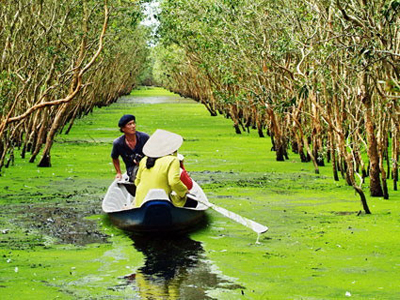U Minh Thuong National Park
Topography and hydrology
U Minh Thuong National Park is located in An Minh Bac commune of An Minh district, and Minh Thuan commune of Vinh Thuan district, Kien Giang province, 365 km south-west of Ho Chi Minh City. U Minh Thuong National Park is located in the plain of the Mekong Delta, and the site reaches only a few metres in elevation. U Minh Thuong or upper U Minh, is the northern of two extensive peatswamp areas in Kien Giang and Ca Mau provinces. The other peatswamp area, U Minh Ha or lower U Minh, is situated 30 km to the south.

U Minh Thuong National Park is situated in an area of freshwater wetlands, comprising peatswamp forest, seasonally inundated grassland and open swamp. The soil layer is covered by a layer of peat, 1 to 3 m thick. The core zone of U Minh Thuong National Park is surrounded by a perimeter canal and dyke system, with a series of gates, which are used to manage the water level. Water is released during the rainy season but, at other times of the year, water is retained.
Biodiversity values
U Minh Thuong National Park supports one of the last significant areas of peatswamp forest remaining in Vietnam, and is recognised as one of the three highest priority sites for wetland conservation in the Mekong Delta. Scientists have classified the vegetation of the core zone into four types: forest dominated by Melaleuca cajuputi on both peat and mineral soils; seasonally inundated grasslands dominated by Phragmites vallatoria and Eleocharis dulcis; open swamps dominated by Nymphaea nouchali, Pistia stratiotes, Salvinia cucullata and Typha domingensis; and natural streams and canals. The vegetation of the buffer zone consists of seasonally inundated grassland, open swamps, Melaleuca plantations, agricultural land, fishponds and canals.
U Minh Thuong harbours a diversity of flora, including many rare and endemic species. 226 species of non-cultivated vascular plants has been recorded. Among these is the duckweed, Lemna tenera, which is rare throughout its range in South-East Asia but common at U Minh Thuong.
The forest and wetlands at U Minh Thuong support many rare and endangered animal species.
A preliminary survey conducted in March 2000 obtained evidence of the continued occurrence of the globally data deficient Hairy-nosed Otter Lutra sumatrana at U Minh Thuong. The survey team also found evidence of Oriental Small-clawed Otter Aonyx cinerea, Sunda Pangolin Manis javanicus and Large-spotted Civet Viverra megaspila at U Minh Thuong.
The conservation importance of U Minh Thuong National Park is further highlighted by the high bird diversity. During a survey of wetland sites in the Mekong Delta by BirdLife International and the Institute of Ecology and Biological Resources, U Minh Thuong had the highest bird species richness of any of the sites visited. To date, 187 bird species have been recorded at U Minh Thuong, including nine globally threatened or near-threatened species: Oriental Darter Anhinga melanogaster, Spot-billed Pelican Pelecanus philippensis, Painted Stork Mycteria leucocephala, Lesser Adjutant Leptoptilos javanicus, Black-headed Ibis Threskiornis melanocephalus, Glossy Ibis Plegadis falcinellus, Greater Spotted Eagle Aquila clanga, Grey-headed Fish Eagle Ichthyophaga ichthyaetus and Asian Golden Weaver Ploceus hypoxanthus.
U Minh Thuong also supports globally significant congregations of a number of commoner waterbird species, including Purple Swamphen Porphyrio porphyrio, Little Cormorant Phalacrocorax niger, Purple Heron Ardea purpurea, Glossy Ibis Plegadis falcinellus. For these reasons, U Minh Thuong qualifies as an Important Bird Area
Other documented values
The Melaleuca forest in the core zone of U Minh Thuong National Park plays an important role in maintaining the soil and water quality in the buffer zone by preventing the acidification of topsoil and surface water, filtering ground water, and storing freshwater during the dry season. In addition, at least eight species of economically valuable fish are found at U Minh Thuong. By providing these services, the U Minh Thuong wetlands make an important contribution to the livelihood security of poor households in the buffer zone.
U Minh Thuong National Park has historical values because the area was used as a base by resistance forces during the First and Second Indochina Wars. Due to the almost complete loss of natural forest in the Mekong Delta region, U Minh Thuong is one of the few places where visitors can see the landscape as it was at the time. In addition, archaeological remains dating back to the Oc Eo civilisation have been found in the area.










